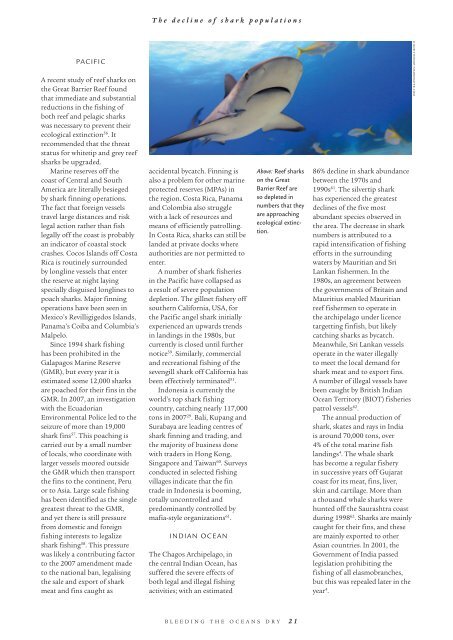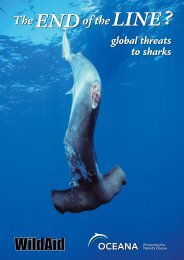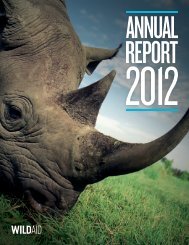Bleeding the Oceans Dry - WildAid
Bleeding the Oceans Dry - WildAid
Bleeding the Oceans Dry - WildAid
- No tags were found...
You also want an ePaper? Increase the reach of your titles
YUMPU automatically turns print PDFs into web optimized ePapers that Google loves.
T h e d e c l i n e o f s h a r k p o p u l a t i o n sPacificA recent study of reef sharks on<strong>the</strong> Great Barrier Reef foundthat immediate and substantialreductions in <strong>the</strong> fishing ofboth reef and pelagic sharkswas necessary to prevent <strong>the</strong>irecological extinction 56 . Itrecommended that <strong>the</strong> threatstatus for whitetip and grey reefsharks be upgraded.Marine reserves off <strong>the</strong>coast of Central and SouthAmerica are literally besiegedby shark finning operations.The fact that foreign vesselstravel large distances and risklegal action ra<strong>the</strong>r than fishlegally off <strong>the</strong> coast is probablyan indicator of coastal stockcrashes. Cocos Islands off CostaRica is routinely surroundedby longline vessels that enter<strong>the</strong> reserve at night layingspecially disguised longlines topoach sharks. Major finningoperations have been seen inMexico’s Revilligigedos Islands,Panama’s Coiba and Columbia’sMalpelo.Since 1994 shark fishinghas been prohibited in <strong>the</strong>Galapagos Marine Reserve(GMR), but every year it isestimated some 12,000 sharksare poached for <strong>the</strong>ir fins in <strong>the</strong>GMR. In 2007, an investigationwith <strong>the</strong> EcuadorianEnvironmental Police led to <strong>the</strong>seizure of more than 19,000shark fins 57 . This poaching iscarried out by a small numberof locals, who coordinate withlarger vessels moored outside<strong>the</strong> GMR which <strong>the</strong>n transport<strong>the</strong> fins to <strong>the</strong> continent, Peruor to Asia. Large scale fishinghas been identified as <strong>the</strong> singlegreatest threat to <strong>the</strong> GMR,and yet <strong>the</strong>re is still pressurefrom domestic and foreignfishing interests to legalizeshark fishing 58 . This pressurewas likely a contributing factorto <strong>the</strong> 2007 amendment madeto <strong>the</strong> national ban, legalising<strong>the</strong> sale and export of sharkmeat and fins caught asaccidental bycatch. Finning isalso a problem for o<strong>the</strong>r marineprotected reserves (MPAs) in<strong>the</strong> region. Costa Rica, Panamaand Colombia also strugglewith a lack of resources andmeans of efficiently patrolling.In Costa Rica, sharks can still belanded at private docks whereauthorities are not permitted toenter.A number of shark fisheriesin <strong>the</strong> Pacific have collapsed asa result of severe populationdepletion. The gillnet fishery offsou<strong>the</strong>rn California, USA, for<strong>the</strong> Pacific angel shark initiallyexperienced an upwards trendsin landings in <strong>the</strong> 1980s, butcurrently is closed until fur<strong>the</strong>rnotice 59 . Similarly, commercialand recreational fishing of <strong>the</strong>sevengill shark off California hasbeen effectively terminated 51 .Indonesia is currently <strong>the</strong>world’s top shark fishingcountry, catching nearly 117,000tons in 2007 29 . Bali, Kupang andSurabaya are leading centres ofshark finning and trading, and<strong>the</strong> majority of business donewith traders in Hong Kong,Singapore and Taiwan 60 . Surveysconducted in selected fishingvillages indicate that <strong>the</strong> fintrade in Indonesia is booming,totally uncontrolled andpredominantly controlled bymafia-style organizations 61 .Indian OceanThe Chagos Archipelago, in<strong>the</strong> central Indian Ocean, hassuffered <strong>the</strong> severe effects ofboth legal and illegal fishingactivities; with an estimatedAbove: Reef sharkson <strong>the</strong> GreatBarrier Reef areso depleted innumbers that <strong>the</strong>yare approachingecological extinction.86% decline in shark abundancebetween <strong>the</strong> 1970s and1990s 61 . The silvertip sharkhas experienced <strong>the</strong> greatestdeclines of <strong>the</strong> five mostabundant species observed in<strong>the</strong> area. The decrease in sharknumbers is attributed to arapid intensification of fishingefforts in <strong>the</strong> surroundingwaters by Mauritian and SriLankan fishermen. In <strong>the</strong>1980s, an agreement between<strong>the</strong> governments of Britain andMauritius enabled Mauritianreef fishermen to operate in<strong>the</strong> archipelago under licencetargetting finfish, but likelycatching sharks as bycatch.Meanwhile, Sri Lankan vesselsoperate in <strong>the</strong> water illegallyto meet <strong>the</strong> local demand forshark meat and to export fins.A number of illegal vessels havebeen caught by British IndianOcean Territory (BIOT) fisheriespatrol vessels 62 .The annual production ofshark, skates and rays in Indiais around 70,000 tons, over4% of <strong>the</strong> total marine fishlandings 4 . The whale sharkhas become a regular fisheryin successive years off Gujaratcoast for its meat, fins, liver,skin and cartilage. More thana thousand whale sharks werehunted off <strong>the</strong> Saurashtra coastduring 1998 62 . Sharks are mainlycaught for <strong>the</strong>ir fins, and <strong>the</strong>seare mainly exported to o<strong>the</strong>rAsian countries. In 2001, <strong>the</strong>Government of India passedlegislation prohibiting <strong>the</strong>fishing of all elasmobranches,but this was repealed later in <strong>the</strong>year 4 .© Rob Stewart/Sharkwater.comb l e e d i n g t h e o c e a n s d r y 2 1





